Health equity has long been an issue for communities of color. This past year, the Black Lives Matter movement and recognition of the impact of COVID-19 on many communities has shed new light on the problem of health inequity.
Social determinants of health (SDH) remain a huge barrier to health equity. The World Health Organization (WHO) has described SDH as non-medical factors that affect health outcomes, such as working and living conditions, income, housing and basic amenities, job security, and access to affordable and decent quality health services.
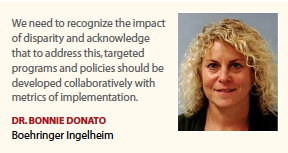 During the COVID-19 pandemic SDH factors have had a huge impact on the prevalence of effects within communities of color. According to data from 16 states, Black people are getting immunized at a much lower rate than white people.
During the COVID-19 pandemic SDH factors have had a huge impact on the prevalence of effects within communities of color. According to data from 16 states, Black people are getting immunized at a much lower rate than white people.
According to analysis from Kaiser Health News, the disparity can be attributed both to access barriers and lack of trust in the healthcare system.
Tackling the Barriers
Undoubtedly, a legacy of racism has led to disparities in the delivery of healthcare as well as poor representation of minorities in clinical trials.
“The lack of admission that health inequality is a systemic problem, where communities of color and lower socioeconomic communities’ needs are often largely ignored is the biggest problem," says Reem Yunis, a director at Medable and head of the company’s internal Diversity, Equity and Inclusion initiative. “When communities are neglected and deprived of resources, it is easy 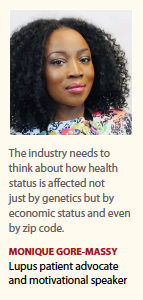 to feel marginalized and then become distrustful of authority or any agency associated with it, including initiatives like clinical research."
to feel marginalized and then become distrustful of authority or any agency associated with it, including initiatives like clinical research."
Health equity is an area that Outcome Health is continuing to devote resources toward, says Matt McNally, CEO, Outcome Health. “We think it is essential for more of us to serve as advocates and leverage our platforms to enable better outcomes for all," he says. “As part of our due diligence and to ensure that our work supports the advancement of Black communities, we interviewed health leaders and advocacy groups. In those discussions, we continued to hear about historical mistrust, as well as ongoing issues of cultural and racial disconnect between providers and Black patients. However, in order for the healthcare industry as a whole to better address health equity, there is the need for brand marketers and HCPs alike to tune in as partners with them and learn how they can better serve Black communities when it comes to their healthcare versus a one-size-fits-all approach."
Nicholas Kenny, Ph.D., chief scientific officer at Syneos Health, agrees there needs to be open acknowledgement of the depth of the issues driving health and healthcare inequity. “While there’s general agreement on what’s wrong and what’s broken, we can clearly see that in the absence of honest assessment of racism, bias, and unequal healthcare access, things will not change," he says. “Institutions that have addressed this head on, with direction and support from senior leaders, are the ones making sustainable and meaningful change. However, we are a long way from streamlining acceptance across all life science organizations."
Today, the urgency for vaccination against COVID-19 is our nation’s most urgent health challenge. “We encourage the entire healthcare community to join us in educating the public, with special initiatives that support Black and other minority voices from BIPOC communities that are often underrepresented," says Bonnie MK Donato, Ph.D., executive director, cardio-metabolic and respiratory health economics and outcomes research at Boehringer Ingelheim.
While there are many barriers to overcoming health inequity, the biggest barrier is access to quality healthcare.
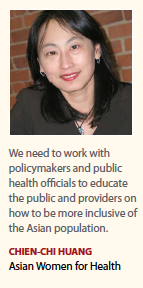 “Effective approaches to addressing disparity in access to care have not been completely achieved," Dr. Donato says. “For example, high-deductible health plans have increased in prevalence from 8% in 2009 to 30% in 2019 among employer-sponsored insurance. This has resulted in many who are unable to afford specialist or follow-up care, taking less medication, using alternative therapies, skipping medications, and delaying filling prescriptions. Additionally, copay accumulator programs exacerbate this issue by effectively nullifying the financial benefit of coupons to patients."
“Effective approaches to addressing disparity in access to care have not been completely achieved," Dr. Donato says. “For example, high-deductible health plans have increased in prevalence from 8% in 2009 to 30% in 2019 among employer-sponsored insurance. This has resulted in many who are unable to afford specialist or follow-up care, taking less medication, using alternative therapies, skipping medications, and delaying filling prescriptions. Additionally, copay accumulator programs exacerbate this issue by effectively nullifying the financial benefit of coupons to patients."
Ms. Yunis concurs that affordability perpetuates poor health outcomes in disadvantaged people by misdiagnosing illnesses, providing lower-quality treatments, and hindering access to clinical trials.
“Greater access to research, which can sometimes be a patient’s only pathway to quality care, is key, but traditional, randomized clinical trials also come with a degree of inaccessibility because of their many inflexible requirements," she says.
“Fortunately, the growing move to a decentralized clinical trial model is finally making it much easier for people of all demographics to participate in trials."
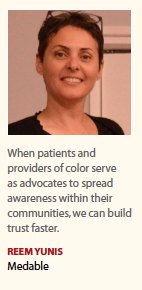 “One of the most ironic and frustrating issues underpinning disparities is the appallingly low rate at which all physicians refer their patients to clinical trials," says Allison Kalloo, a member of Medable’s Patient Advisory Council (PAC).
“One of the most ironic and frustrating issues underpinning disparities is the appallingly low rate at which all physicians refer their patients to clinical trials," says Allison Kalloo, a member of Medable’s Patient Advisory Council (PAC).
Rodney Gillespie, VP, oncology sales and market, solid tumor, Janssen Oncology, says there are two significant barriers. The first is systemic racism. The other barrier is a lack of education on both sides of the equation.
“We need to educate healthcare workers how to recognize racism," Mr. Gillespie says. “And we need to educate people of color to stand up for themselves, to push back, to have a voice. In order to do that, they need to understand the issues and be aware of all their potential screening and treatment options. Once they do that, we will begin to lose this distrust of the medical system that, while understandable in the past, is now interfering with care and outcomes."
He adds that to help people truly understand the reality that Black people face in the health system, there needs to be more outcomes data from across healthcare — for diabetes, for blood pressure, for heart disease, and for cancer.
“We need more retrospective studies — and more prospective studies — published in widely respected medical journals, such as the New England Journal of Medicine — showing the outcome when there is this type of disparity," Mr. Gillespie says.
“Ultimately, we need to measure quality of life, in addition to mortality differences.
“We also need more accountability for the problem within government and the private sector," he adds. “We have to get to the point at which, if you see racial inequity in your healthcare setting, you have to do something about it. When you start to collect the data, you bring more science to a problem, you take away subjectivity, and you make it real."
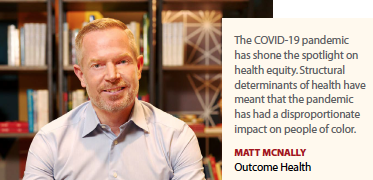 Dr. Kenny says holistic education, awareness, and acknowledgement are the first steps in driving change. “Next, there has to be intentional proactive design change where institutions take the opportunity to perform drug development in a scientific and ethically sound manner," he adds. “In short, all segments and demographics of our society have the right to equity of access to clinical trials – and drugs should be developed in patients who are representative of the disease burden."
Dr. Kenny says holistic education, awareness, and acknowledgement are the first steps in driving change. “Next, there has to be intentional proactive design change where institutions take the opportunity to perform drug development in a scientific and ethically sound manner," he adds. “In short, all segments and demographics of our society have the right to equity of access to clinical trials – and drugs should be developed in patients who are representative of the disease burden."
Ms. Kalloo says the barriers to health equity won’t be overcome until decision-makers commit to it, invest in it, and make their accountability measures transparent.
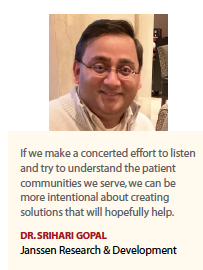 Public attitudes also have a huge impact on health outcomes. According to Chien-Chi Huang, founder and executive director of Asian Women for Health, while racism is not new to Asian-Americans, since the pandemic the situation has worsened, with Asian women often being attacked and blamed for the virus.
Public attitudes also have a huge impact on health outcomes. According to Chien-Chi Huang, founder and executive director of Asian Women for Health, while racism is not new to Asian-Americans, since the pandemic the situation has worsened, with Asian women often being attacked and blamed for the virus.
“I personally experienced a verbal attack on the subway," she says. “All of this has a huge impact on not just our physical well-being but also our mental and emotional well-being. I work with a lot of Asian women who have underlying health conditions and they’re afraid to go outside in the public."
Confronting The Effects of Inequity
Mr. Gillespie says health inequities affect mortality rates, quality of life, and earnings potential, which in turn affects how patients live with and treat their disease.
“An example is prostate cancer in the Black community," he says. “Black men die at twice the rate as men of European descent. That is directly connected to health inequities."
One way that Mr. Gillespie is raising awareness about the impact prostate cancer has on the Black community is through his involvement with the Blue Jacket fashion runway. “The Blue Jacket Fashion Show was a must-do event for me because of my passion for helping people, in particular men with prostate cancer," he says. “The disease has a huge impact on the Black community. When we look at the data, we can see inequity in the way prostate cancer is being diagnosed and treated: Black men are twice as likely to die of the disease. This goes back to my passion: bring the science and show the outcomes, then we can do something about it."
He says the show helps to raise awareness because it is held during Fashion Week and helps to balance fun and education, which gets men’s attention.
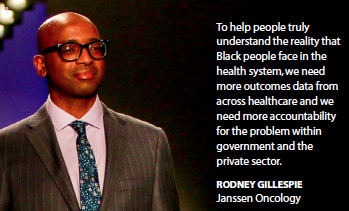 “We all know that men just don’t go to the doctor as often as we need to," he says. “So, the goal is for men to take personal accountability — and take action."
“We all know that men just don’t go to the doctor as often as we need to," he says. “So, the goal is for men to take personal accountability — and take action."
Dr. Donato says it’s important to keep documenting the healthcare disparities related to access to care, understand why they exist, and collaboratively develop targeted programs and policies with metrics of implementation. She cautions, however, it’s important to recognize potential inherent bias in the data used to inform health programs and policies.
“For example, if the analysis focused on how much is spent for healthcare, this does not take into consideration those forgone services," she says. “Once programs and policies have been developed, support and financial infrastructure to implement them must exist, as well as predefined metrics and an implementation feedback loop."
More research is being carried out into SDH and programs engaging with and addressing underserved patient populations. For example, Dr. Donato points to a recent study that highlights the impact of high-deductible healthcare plans on access to care among oncology survivors, and how much greater the impact was among Black versus white survivors.
“We have recently launched several studies to further document drivers of healthcare disparity in other patient populations," she says. “The focus is to further expand the understanding of the degree to which disease types impact healthcare disparity, the relationship with sociodemographic factors, and the drivers impacting equitable healthcare."
In an effort to address inequities, many community groups are taking a direct-action approach, including to ensure underserved communities are vaccinated against COVID-19. In Miami, for example, a nonprofit, community-based group called Healthy Little Havana has been going door to door to encourage residents in low-income neighborhoods that are typically home to people from Latin America to take a COVID-19 test.
Another community that is often overlooked in issues of disparity is Asian-Americans, Ms. Huang says.
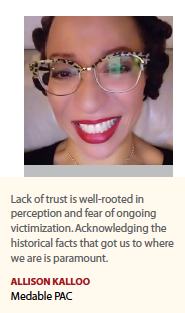 “There is the model minority myth that all Asians are supposed to be wealthy, healthy, and well-educated," she says. “We need to work with policymakers and public health officials to reduce structural barriers, including access and representations of underserved, under-resourced populations in clinical trials and research."
“There is the model minority myth that all Asians are supposed to be wealthy, healthy, and well-educated," she says. “We need to work with policymakers and public health officials to reduce structural barriers, including access and representations of underserved, under-resourced populations in clinical trials and research."
Industry Responsibility
Srihari Gopal, M.D., head of development, psychiatry, for Janssen Research & Development, says it’s not enough for pharmaceutical companies to develop medicines, they must be made available to those who need them, when they need them, in the most safe and cost-effective way.
“Furthermore, at Janssen, we believe it is essential for patients to have a seat at the table every step of the way to ensure that everything we are doing from drug discovery/development and beyond has been informed by true patient/community needs," he says. “We have also made a concerted effort to include these diverse populations in our clinical studies. By doing so, we hope to explain how we develop new medicines, and thereby improve trust."
Dr. Donato agrees that actively encouraging and enrolling diverse populations into clinical trials is an industry imperative.
“We can support research into social determinants of health in a cohesive fashion, considering all potential factors of impact," she says.
Ms. Huang says the healthcare industry needs to provide patient-centered care by giving culturally and linguistically relevant care and support. There also needs to be more support to 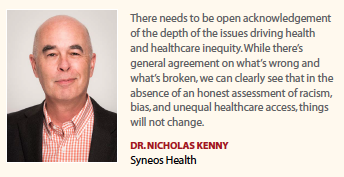 help minorities become medical professionals, perhaps through scholarships, and then supporting those professionals to do more community-led research projects.
help minorities become medical professionals, perhaps through scholarships, and then supporting those professionals to do more community-led research projects.
“A pharmaceutical company can’t simply say it is patient-centric; it truly needs to be patient-centric, listening to the community and actively working to address unmet needs," Dr. Gopal says.
Many patient advocates and industry leaders also underscore the need for healthcare organizations and pharmaceutical companies to start acknowledging past atrocities, such as the 1932 Tuskegee Study of Untreated Syphilis in the Negro Male, and start a dialogue to understand the concerns of marginalized communities.
“Unfortunately, we’re dealing with both mistrust, which is lack of confidence, and distrust, which is based on history, such as fear about repeating something exploitive," Ms. Kalloo says. “Responses by Black people to the COVID vaccine spotlight both vacuums of trust. Not fully accepting or acknowledging the nature of this lack of trust is the biggest barrier to overcoming it."
The way to overcome these barriers is to become worthy of trust, Ms. Kalloo notes.
“Companies need to support local educational initiatives that center around creating better health outcomes," she says. “They need to embrace a continuous feedback loop and take criticism with grace. They need to operationalize ways to consistently collect input from patients the way Medable is doing with its PAC. Then, they need to follow through with those recommendations. To make equity initiatives truly authentic, companies need to partner with historically underutilized businesses to put those suggestions into action."
“We need to call out what racism looks like and what marginalization looks like," says Monique Gore-Massy, a global and national lupus patient advocate. “Companies want patients to get involved, to do surveys, to have the vaccine, but trust is an issue.
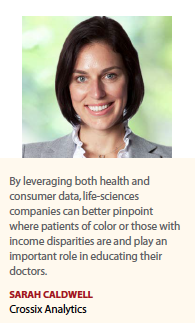 We can’t just put the burden on the marginalized individuals, the individuals who were mistreated and misappropriated. The burden also has to be put on the industry acknowledging past wrongs.
We can’t just put the burden on the marginalized individuals, the individuals who were mistreated and misappropriated. The burden also has to be put on the industry acknowledging past wrongs.
“Those organizations need to include patient leaders in those communities right from framing a clinical trial and preparing guidelines and policies for a vaccine rollout; then the industry needs to ask those patients about their experience," Ms. Gore-Massy adds. “There also need to be health literacy programs, not just for patients but also for clinicians and medical residents so those individuals understand the cultural, linguistic, educational, and even religious barriers. Beyond that, the industry needs to invest outside of just the scope of healthcare. Companies need to invest in schools, in neighborhoods, in food sources, in technology — especially now with telemedicine."
Sarah Caldwell, general manager of Crossix Analytics, Veeva Systems, says since the life-sciences industry’s mission is to improve health and well-being, it’s crucial for companies to find new ways to reach underserved patient populations. “By leveraging both health and consumer data, life-sciences companies can better pinpoint where patients of color or those with income disparities are and play an important role in educating their doctors," she says. “This deeper understanding of the patient profile can also support patient education and support programs tailored to the needs of underserved populations."
Dr. Donato says the industry can also improve equity by committing to further expand a diverse workforce.
“Bringing a diverse workforce together can encourage innovative approaches and thinking on supporting access to healthcare, as well as provide a forum for diverse voices to be heard," she says.(PV)
~~~~~~~~~~~~~~~~~~~~~~~~~
Patients’ Voices
 Roxanne is an MS patient whose podcast Spilling Tea with Roxy discusses all thing MS-related.
Roxanne is an MS patient whose podcast Spilling Tea with Roxy discusses all thing MS-related.
The main barrier I faced was the acceptance that a black woman of mixed raced heritage could present with my condition, multiple sclerosis. Even though my symptoms were typical to MS, doctors diagnosed me as having lupus because it is more typical for someone of my racial background. This set my diagnosis back by six years, and I didn’t get any treatment until eight years after my first symptom. Throughout that journey, I was trying to advocate for myself but was being ignored. No matter how hard I tried to get the treatment I needed for my condition, doctors refused to sign off on it.
The experience led me to become an advocate for other patients. I have helped my community by creating a podcast to highlight and talk about things the doctors won’t. Nothing is off the table. I share what I can to create change in the community. Patient advocates are so important in addressing health inequities. By verbalizing people’s concerns, they provide reassurance.
Furthermore, it’s easier to talk to someone who resembles you or who you believe understands what you are dealing with health-wise..
 Chien-Chi Huang is a breast cancer survivor, founder of Asian Breast Cancer Project, and Executive Director of Asian Women for Health.
Chien-Chi Huang is a breast cancer survivor, founder of Asian Breast Cancer Project, and Executive Director of Asian Women for Health.
I’m an immigrant from Taiwan. I came to the United States as an international student. I got my master’s degree in mass communication, but I could barely carry a conversation in English when I first arrived. During my treatment for breast cancer, I felt really alone because there were no resources catering to Asian women.
Many Asian women were misinformed, misdiagnosed, and mistreated because of cultural and linguistic barriers. Some believe breast cancer is a white woman’s disease because we rarely see Asian breast cancer survivors or patients in the mainstream media.
Also in the United States, Asian women have the lowest screening rate of all populations. And yet, there is an 89% increase of breast cancer among Asian women in Massachusetts from 1999-2013. We did a research study in collaboration with Tufts University and learned that irrespective of social and economic status or education level, cultural barriers are huge. Many don’t believe in western medicine and only go to the doctor when they are sick.
One of the most effective tools to help address these barriers is through storytelling, because through storytelling people can really relate to the speaker, the patient advocate. They might speak the same language or have the same cultural background. They understand what the barriers are and how to deal with those.
Social media also plays a key role because it can transcend time and space and the language barrier. However, not everybody has access to the technology or is savvy about using the internet or has the bandwidth.
 Monique Gore-Massy is a global and national lupus patient advocate and motivational speaker.
Monique Gore-Massy is a global and national lupus patient advocate and motivational speaker.
After bouncing around from doctors to emergency rooms to specialists, I was finally diagnosed with lupus in 2010, and at the time I knew nothing about the condition. I began an aggressive treatment and had a very rough time for the first four or five years, with organ failure, losing my eyesight, and losing my mobility. I wasn’t informed much about the repercussions of the medications that I was taking.
I began seeking ways to engage with others and found out about Walk to End Lupus, and I have now been involved for 10 years. I have formed such a great network of patients and care partners. Many patients like me were unaware of the unconscious or implicit bias in the system. A lot of patients passed away just because of inappropriate or inaccessible care.
One example that underscores the issue of bias and health inequity is the attitude to patients based on where they live. There is a robust West Indian, African, and Caribbean community in Brooklyn with many first homeowners and college graduates. But when I was going to one facility, there was an assumption that we would not be compliant. At one conference I overhead a reference to Brooklyn lupus versus Manhattan lupus, which meant patients from Brooklyn were expected to be late for appointments, not able to fully understand our care, and cumbersome to get involved in clinical trials. I had such issues with a specialist I was seeing that I had to seek out better care, and that happened to be in Manhattan. That should not be the case.
Our health should not be impacted by our zip code or our economic status.
Minorities are disproportionately affected by lupus yet only 14% of individuals in clinical trials are Black and 3% are Hispanic.
Today, I’m working nationally with several organizations to amplify the patient voice and I’m doing global advocacy work with the Lupus Foundation. We are looking to partner with researchers, scientists, and healthcare professionals with regard to the COVID-19 pandemic.
I am also working on boards for different pharma organizations to bring awareness about the lack of diversity in clinical trials and how that can be improved.
~~~~~~~~~~~~~~~~~~~~~~~~~
Addressing Health Equity with Patient-Centricity
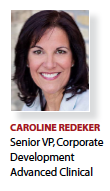 Janssen Neuroscience has recognized that diseases as complex as those of the brain require an equally complex approach, centered on the unique needs, goals, and circumstances of the individual patients, as well as the loved ones who support them. It truly requires a patient-centric approach to deliver transformational medical innovations.
Janssen Neuroscience has recognized that diseases as complex as those of the brain require an equally complex approach, centered on the unique needs, goals, and circumstances of the individual patients, as well as the loved ones who support them. It truly requires a patient-centric approach to deliver transformational medical innovations.
Recognizing these challenges, the organization has created opportunities to collaborate with those impacted by schizophrenia in many ways and through multiple touch points, including:
Surveying and analyzing patient and caregiver perspectives of disease burden during clinical trials.
Developing the “Healthy Minds" video series that features patients living with schizophrenia.
Sponsoring a podcast discussing serious mental illness in diverse communities.
Empowering people living with schizophrenia to play an active role in their treatment plan by educating patients and caregivers about treatment choice. This includes a partnership with patients and caregivers on OnceMonthlyDifference.com, including a personal preparedness plan to help patients and loved ones plan ahead and take action when an episode strikes.
Partnering with internet personality and New York Times bestselling author Hannah Hart, who is a caregiver to her mother who lives with schizophrenia and partnering with The Mighty to share stories from people living with schizophrenia and their caregivers.
Partnering with mental health advocacy organizations like Mental Health America (MHA) and National Alliance on Mental Illness (NAMI) and through Choices in Recovery resources and programs, disseminated through a team of community mental health liaisons, who are active members of the mental health community in regions across the country.
Offering financial assistance options and providing ongoing support to help patients stay on therapies that are effective for them.
~~~~~~~~~~~~~~~~~~~~~~~~~
Addressing Health Equity in Clinical Trials
With significant opportunity to improve, the clinical research industry has started to develop and implement various studies, assessments, and work groups to address the lack of diversity in clinical trials. For example, The Multi-Regional Clinical Trials (MRCT) Center was developed by Brigham and Women’s Hospital and Harvard, which implemented a ‘diversity’ workgroup to clarify the meaning and to ensure that participants in clinical research represent a diverse population. Additionally, CISCRP launched a Patient Diversity Campaign to promote participation in clinical trials to diverse, minority, and underserved communities. Further, the FDA established a new guidance in 2020 intended to enhance the eligibility of diverse populations in clinical trials by encouraging biopharma to reassess factors such as enrollment practices and trial design to ensure inclusivity. However, despite the recent efforts, the industry has much more work to do in order to increase diversity in clinical trials.
This is an opportunity for professionals in our industry to lead the conversation and influence change. For example, Advanced Clinical started addressing these gaps by educating and training the employees on the importance of diversity and inclusion companywide, developed a diversity and inclusion committee, and have included this topic into leadership goals. In addition, the company is also developing relationships with principal investigators who represent various populations globally and are using tools to help reach different populations. We are committed to contributing to the industry progress this year and are excited to help foster diverse thinking into best practices for our company and our clients.
With patients of color and healthcare workers vastly underrepresented in clinical research, there is an opportunity for more diverse populations to be better served. Two areas of needed growth include the use of clinical data from patients in diverse populations and perspectives from diverse healthcare workers to provide a different way of thinking in the development of clinical trials. Contract research organizations, regulators, trial sponsors, and the life science industry at large must come together and work toward implementing meaningful and measurable improvements. One immediate area for change is ensuring that principal investigators and site staff that are selected for each trial represent diverse populations. Healthcare workers from diverse populations will help increase potential patients by increasing trust in the benefit of volunteering for a clinical trial. Until people can identify with the trial advertisement or the workers that are offering the opportunity, many will be hesitant to volunteer or participate.
Each of us can start within our own organizations by making sure our hiring practices include recruiting from various sources in a variety of populations and ensuring we have diverse staff with diverse thinking (age, race, background, industry), which will give us a better outcomes. By holding ourselves accountable within our organizations to ensure diversity is a priority in our hiring, our thinking, and our practices, we can succeed together. If people commit to this approach, our industry will see improvements in the way we include diverse populations and improve representation across trials.


















